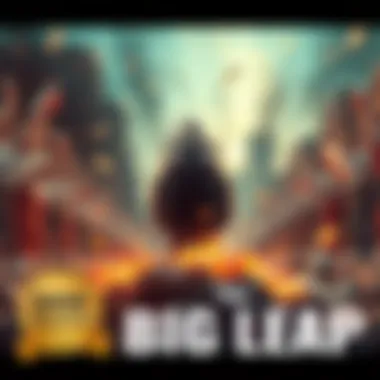Insights on The Big Leap: Overcoming Personal Limits


Intro
In exploring Gay Hendricks’ thought-provoking work, The Big Leap, readers embark on a journey that dives deep into the nuances of personal transformation. This book operates on the premise that many individuals face self-imposed constraints that prevent them from fully reaching their potential. Such constraints, termed the Upper Limit Problem, serve as a barrier, holding people back from experiencing success and fulfillment in their lives. This article will guide readers through the ins and outs of Hendricks’ ideas, breaking down the core principles and their real-world applicability.
Through insightful analysis, we will touch on the complexities of personal growth, the fear that often keeps individuals tethered to familiarity, and how one can navigate these hurdles to unlock their true capabilities. As we dissect the book into relevant categories and key insights, anticipate a comprehensive understanding that not only informs but also inspires.
The concepts presented in The Big Leap resonate well beyond the pages of the book; they reflect a universal struggle to transcend personal limits and embrace the vast potentials that life has to offer. Let’s delve into the categories and frameworks that shape this exploration of personal growth.
Prelude to The Big Leap
In the landscape of personal development literature, "The Big Leap" by Gay Hendricks stands out as a compelling exploration of the barriers we create for ourselves on the path to growth. Understanding this book is crucial because it delves into significant themes such as self-sabotage and the transformative power of acknowledging one's true potential. By examining these concepts, readers are equipped with the tools to identify and overcome the self-imposed limitations that hinder their success.
Hendricks articulates an essential truth: the beliefs we hold can propel us forward or drag us back. The importance of this topic extends beyond mere theory; it resonates in practical, everyday scenarios where individuals find themselves stymied by invisible ceilings. Recognizing this phenomenon provides a clearer lens through which to view personal obstacles as more than just external challenges. Instead, they often stem from deep-rooted fears and outdated narratives about what one can and cannot achieve.
Moreover, the book insists on the urgency of embracing our "Zones of Genius", those unique talents that can foster extraordinary results when cultivated properly. As will be discussed, this concept resonates strongly in modern discussions about productivity and fulfillment. Thus, the significance of exploring Hendricks' work lies not just in intellectual appreciation, but also in its practical implications for anyone aiming to leap into their next phase of life.
"The only thing that stands between you and your big leap is the thoughts you are thinking."
By undertaking this examination, we aim to provide insights into how to break through these barriers to enhance both personal and professional lives. The next section will give an overview of the book itself, providing context and foundational understanding before diving deeper into its core concepts.
Overview of the Book
"The Big Leap" presents the idea that there exists an unconscious threshold we set for how much success and happiness we allow ourselves to experience. Hendricks introduces readers to the concept of the Upper Limit Problem, describing how this self-imposed limit restricts us from living our best lives. This theme is not only relatable but also actionable, fostering a desire for change among readers.
The book is a blend of anecdotal evidence, personal reflections, and actionable strategies. It encourages readers to take stock of their beliefs and examine the narratives they maintain around their abilities and deservingness of success. With anecdotes drawn from Hendricks' career and experiences, the work feels approachable and relevant, dispelling any notion of esoteric self-help.
The Author's Background
Gay Hendricks, the mind behind this impactful work, is not a mere theorist—he is a seasoned psychologist with decades of experience in the field. His background includes an extensive study of relationships and personal growth, which adds a layer of credibility and depth to his assertions. Having authored multiple books, Hendricks combines research with practical wisdom, making his ideas compelling in both academic and casual settings.
His journey has informed much of his thinking about limitations. From working with high performers to addressing their inner challenges, he gets close to the heart of what holds people back. This perspective is pivotal as it frames "The Big Leap" as more than a self-help guide; it’s a manual for anyone looking to elevate their experience of life.
As we delve further into the central concepts of this article, it’s worth keeping in mind the author’s mission: to eliminate the internal barriers that stand in the way of our highest potential.
Core Concepts
Understanding the core concepts presented in 'The Big Leap' is essential for grasping the transformative potential within ourselves. Gay Hendricks, through meticulous examination of self-imposed limitations, delves into how these barriers can be dismantled to allow us to thrive. This section dissects three pivotal themes from the book that serve as the foundation for personal growth: the Upper Limit Problem, Zones of Genius, and the interplay of fear and resistance. By engaging with these elements, readers can embark on their own journey to significant change and self-discovery.
Understanding the Upper Limit Problem
The Upper Limit Problem refers to the subconscious barriers we create that prevent us from experiencing greater joy and success. Hendricks posits that many individuals encounter resistance when they approach new heights of comfort and achievement. This phenomenon is often driven by internal scripts—beliefs ingrained in us since childhood—that suggest we don’t deserve happiness or success beyond a certain tipping point.


To put it simply, when life seems to begin overflowing with good fortune or happiness, many start subconsciously self-sabotaging behaviors. This looks like a relationship falling apart, financially backsliding, or health-related issues cropping up seemingly out of nowhere. It’s as if we are constantly fighting against our own better nature, deeply rooted in an unyielding fear of what might happen if we climb too high.
"The only thing standing between you and your goal is the story you keep telling yourself as to why you can’t achieve it." – Jordan Belfort
Recognizing this challenge involves deep introspection and the willingness to change those limiting narratives we tell ourselves. This understanding can be a game-changer, redirecting the focus from what holds us back to what propels us forward.
Defining Zones of Genius
Zones of Genius are the activities and areas where we excel and find great joy. Identifying these zones is crucial in maximizing our potential. Hendricks points out that each person has unique talents to offer the world; however, too often, we're caught up doing things out of necessity rather than passion or inherent ability. One might be a great communicator but spends their days in data analysis, thus missing out on fulfilling their true potential.
To harness this concept, individuals should reflect on moments when they felt truly engaged, energized, and skilled—the times when hours seemed to fly by. This exploration could lead to discovering paths that resonate deeply, not only enhancing personal satisfaction but also fostering professional fulfillment. It's about harnessing that wellspring of energy to center our lives around what ignites our spirits and enriches our capabilities.
The Role of Fear and Resistance
Fear and resistance play monumental roles in our lives, often acting like an anchor when we seek to ascend beyond our current state. Fear can manifest in numerous ways, from the fear of failure to the fear of success itself. The irony lies in how we can fear our own triumphs just as much as we fear our setbacks. This duality creates an insidious cycle: we want to leap forward, yet that impulse is met with paralyzing doubt or anxiety, keeping us firmly in place.
Resistance can be understood as the voice in our head that tells us we shouldn’t even try. Tuning into how this resistance presents itself in our lives becomes crucial. To combat it, one must first acknowledge its presence and understand it doesn't have the power to dictate our actions unless we let it. By reframing how we view fear—as a natural, albeit uncomfortable, aspect of growth—we can begin to see it not as a barrier but rather as a signpost, guiding us toward areas where we need to evolve.
In summary, embracing the core concepts of 'The Big Leap' equips us with insight and strategies for unearthing our potential. As we navigate through our Upper Limit Problems, refine our Zones of Genius, and confront our fears, we take substantial strides towards genuine growth and the remarkable life we deserve.
Practical Applications
Practical applications of the concepts from The Big Leap serve as the bridge between theory and the reality of personal transformation. Understanding these applications is critical for anyone seeking to break free from their self-imposed limitations and pursue their true potential. Identifying where and how to implement these ideas in daily life can lead to significant shifts in mindset and behavior.
The benefits of applying the core principles of the book are vast. For one, it enables individuals to actively confront their fears and recognize when self-limiting beliefs rear their heads. This self-awareness is the first step in dismantling those barriers. The practical applications also underscore the significance of a supportive environment—a surrounding that nurtures growth and encourages individuals to step outside their comfort zones.
Ultimately, the strategies that stem from The Big Leap can catalyze profound change in various aspects of life, from careers to personal relationships. Implementing these practices not only enhances personal satisfaction but also elevates the collective consciousness of the community, as individuals inspire those around them to pursue their own greatness.
Strategies for Overcoming Self-Limiting Beliefs
One of the primary hurdles many face is the insidious nature of self-limiting beliefs. These ingrained thoughts impose caps on what individuals think they can achieve. Overcoming these beliefs is not merely about positive thinking; it’s about a comprehensive approach to restructuring one’s mindset.
To start, one practical strategy is to identify these beliefs through journaling. Writing down thoughts each day can help reveal patterns of negative self-talk. Once identified, it’s important to challenge these thoughts. Ask questions like:
- Where did this belief originate?
- Is it based on factual evidence or personal perception?
- What would I tell a friend in a similar situation?
This reflective process can facilitate a shift in thinking, making an emotional breakthrough possible. It’s about moving from a place of fear to one of empowerment, enabling individuals to envision their potential and act on it.
Integrating the Zones of Genius into Daily Life
Hendricks emphasizes the importance of identifying and nurturing one's Zone of Genius. This zone represents the activities that an individual is naturally good at and loves doing. Integrating these activities into daily life requires conscious effort and a recommitment to prioritize what genuinely brings joy and fulfillment.
One effective method to achieve this is by conducting a time audit. In this audit, individuals track how they spend their time hourly for a week.


- Identify activities that energize you.
- Look for those that drain your energy.
The aim is to notice where you find flow and infusion of energy, and where you feel drained and restricted. From this, plans can be made to allocate more time to those activities that enrich life while minimizing exposure to those that do not.
Additionally, setting boundaries can be crucial. It’s easy to say yes to everything that comes your way. However, respecting your need for time to engage in your genius activities can make a world of difference.
Creating a Supportive Environment
Creating a supportive environment is pivotal for sustaining personal growth. As the saying goes, "you are the average of the five people you spend the most time with," making it clear how important one’s surroundings can be. This environment should foster encouragement, positivity, and open communication.
To build such an environment, consider the following:
- Choose your circle wisely: Surround yourself with individuals who celebrate your successes and support your aspirations.
- Engage in communities that share your interests: Whether in professional groups or hobby-oriented clubs, find spaces where you feel understood and uplifted.
- Encourage open dialogue: Establish a practice of sharing thoughts and feelings freely among peers, cultivating a safe space for vulnerability and growth.
This supportive backdrop can serve as a powerful motivator to leap into one’s Zones of Genius without hesitation.
Case Studies and Testimonials
Understanding the personal experiences and results of others can provide invaluable insights, particularly when grappling with concepts introduced in 'The Big Leap.' These case studies and testimonials serve not just as anecdotes, but also as real-world evidence that the principles outlined can ignite transformative change. Evaluating how others have navigated their journeys underscores the practical relevance of the book, encapsulating hardships, triumphs, and sustained progress that come from embracing one's true potential.
Testimonials resonate deeply because they humanize theoretical concepts. They show us that these ideas aren't just lofty principles but tangible, actionable frameworks that have altered lives. Not only do they demonstrate the efficacy of applying Hendricks's teachings, but they also help illustrate common hurdles that emerge along the path to growth. By examining both the successes and failures of practitioners, readers can glean practical strategies while building realistic expectations.
Real-Life Success Stories
Diving into real-life success stories reveals a treasure trove of inspiration. Take, for instance, the experience of a corporate executive who felt stifled and unfulfilled in a high-pressure job. After discovering 'The Big Leap,' this individual recognized the Upper Limit Problem lurking behind self-doubt and fear of success.
They began identifying their Zones of Genius — the activities that sparked joy and passion in their life. By daring to shift their focus from a stable but unfulfilling position to launching a consultancy based on their true strengths, they reported heightened creativity and productivity. The move was not without its challenges, yet by seeking support from peers and leveraging strategies found in Hendricks's work, they managed to soar above their previous limitations.
Such stories highlight the potential that lies within each person. They demonstrate that it's possible to liberate oneself from self-imposed constraints, aligning action with genuine interests rather than societal expectations. Here are some key takeaways from these accounts:
- Embracing one's authenticity can lead to unimagined opportunities.
- The journey often requires robust support systems for encouragement.
- The path isn’t linear: setbacks may occur, but they can offer valuable lessons.
Lessons Learned from Practitioners
The experiences of practitioners provide a wealth of insight to anyone willing to examine them closely. Common threads emerge from their journeys, allowing others to navigate their own paths more effectively. These lessons gleaned from real-world application of Hendricks's teachings can act as guideposts:
- Self-Reflection Is Crucial: Regular introspection allows individuals to identify their own limits, fears, and Zones of Genius. These moments of clarity can catalyze significant change, steering one toward more fulfilling experiences.
- Fear Must Be Addressed: Many practitioners reported that facing rather than avoiding fear transformed their approach to challenges. The act of addressing fears directly often diffused their hold, allowing for progress.
- Building a Community Is Essential: Isolation can stifle growth. Creating or joining a supportive community encourages accountability and provides diverse perspectives that enrich the journey.
In summary, the wealth of case studies and testimonials serves as both a map and a mirror for readers. They not only illuminate the journey of overcoming self-imposed limitations but also validate the transformative nature of applying the principles from 'The Big Leap.' As practitioners navigate their own roads to success, these stories illuminate the versatility of Hendricks's concepts, allowing them to anticipate pitfalls while nurturing their aspirations.
Comparative Analysis


In the evolving landscape of personal development literature, conducting a comparative analysis regarding 'The Big Leap' proves essential for understanding its standing among similar works. The personal growth arena is flooded with various writings that aim to help individuals break through mental barriers and achieve their full potential. By examining Gay Hendricks’ insights alongside other self-help texts, one can glean the unique nuances of his approach and identify the methodologies that resonate more profoundly with readers.
This analysis reveals the distinct framework Hendricks offers. Notably, one of the merits of this comparative approach lies in illuminating the recurring themes of self-imposed limitations that tend to surface in many self-help books. Such insights can drive discussions about how these themes manifest across different authors and schools of thought.
Comparison with Other Self-Help Literature
When placed alongside other self-help classics, such as 'The Power of Now' by Eckhart Tolle and 'The 7 Habits of Highly Effective People' by Stephen R. Covey, a few striking contrasts appear. For instance, while Tolle emphasizes the importance of present awareness, Hendricks dives into the psychological barriers that inhibit embracing this moment fully. Both underscore the significance of being mindful, but Hendricks takes a unique angle focusing on the internal fears that hold individuals back.
- Focus on Fear: Other books might address fear from a theoretical standpoint. In contrast, Hendricks brings forth a practical narrative on how fear shapes our realities. He offers actionable frameworks, which make his insights profoundly applicable.
- Holistic Approach: Hendricks stresses a blend of emotional and intellectual breakthroughs, diverging from purely cognitive frameworks others might propose. Instead, he incorporates the heart, opening doors to a broader understanding that provides a deeper contextual influence on his practices.
- Zoning Genius: The concept of Zones of Genius stands out as a unique contribution, allowing readers to identify and cultivate their individual strengths more effectively than just setting generic goals often seen in self-help literature.
When juxtaposed with works like 'Mindset' by Carol Dweck, where the focus is on the dichotomy of growth and fixed mindsets, Hendricks adds dimension by illustrating how these mindsets relate directly to the Upper Limit Problem. Such distinctions are paramount as they help readers align their personal development elucidation with their mental barriers.
The Big Leap's Unique Contributions
Hendricks' profound contributions can be framed around how they resonate deeply with the multifaceted challenges individuals encounter. In stark contrast to many self-help texts, The Big Leap is not merely a guide; it serves as a manual for dissecting inner dialogues and peeling away layers of self-doubt.
- Detailed Framework for Personal Analysis: Hendricks meticulously outlines the Upper Limit Problem, giving readers a concrete tool to assess where their limitations lie. Other books may touch on self-awareness, but none dissect it with such clinical precision.
- Empowerment Through Structure: While many authors encourage positive thinking, Hendricks integrates practical exercises that actively involve readers in their growth process. By emphasizing self-reflection, he cultivates a sense of agency among his readership.
- Simplicity in Complexity: His concepts are presented in a digestible way, allowing even those new to personal development to engage with complex ideas without being overwhelmed. Hendricks’ practical applications, such as understanding Zones of Genius, create an accessible route to mastering one’s potential.
Critiques and Limitations
Examining "The Big Leap" and its insights necessitates a critical eye towards the critiques and limitations surrounding Hendricks’ work. While the book has garnered acclaim for its approach to personal development, the discussions around its weaknesses reveal a nuanced landscape that is equally important for readers. Acknowledging these critiques helps to form a balanced understanding of the material.
The value of exploring critiques cannot be overstated. It not only promotes critical thinking but also aids in identifying areas where the concepts may fall short in practical application. Readers are encouraged to consider how these limitations could affect their personal journey through growth and change. By dissecting both the strengths and weaknesses of "The Big Leap," one can gain a more comprehensive grasp of personal development strategies and their respective effectiveness.
Common Critiques of the Book
Several critiques of "The Big Leap" have emerged over time, highlighting potential shortcomings in its arguments:
- Oversimplification of Problems: Some critics argue that Hendricks simplifies complex emotional and psychological issues. They suggest that feelings of fear and self-sabotage cannot be neatly categorized or easily overcome simply by recognizing them.
- Lack of Empirical Evidence: Unlike mainstream psychological practices that lean on research-based methodologies, critics question the anecdotal nature of the material. Without robust empirical studies backing up the claims, some readers remain skeptical of its applicability in diverse real-world contexts.
- Cultural Considerations: The concepts may not fully resonate with readers from different cultural backgrounds. What feels like a limitation in one culture may not have the same weight in another, suggesting a need for a more inclusive approach.
Limitations in Practical Application
While "The Big Leap" offers transformative ideas, its application in everyday life is not without limitations:
- Actionability of Concepts: For some, the concepts may seem profound, yet translating these ideas into actionable behavior can be a different kettle of fish. Many readers struggle to implement the Zones of Genius framework in their daily routines effectively.
- Generality of Strategies: The strategies presented are broad and may not be tailored enough for individuals facing unique circumstances. This limitation could lead to frustration for those seeking specific guidance.
- Resistance to Change: Naturally, individuals may experience a range of emotional and psychological barriers that impede their growth. The book’s suggestions, while well-intentioned, may not sufficiently account for deeply ingrained habits that resist change, rendering them ineffective in certain scenarios.
Ending
In wrapping up this exploration of Gay Hendricks' 'The Big Leap,' we find ourselves at a critical juncture, reflecting on the myriad insights that have arisen. This book is not just a guide; it is a roadmap towards unlocking one’s potential by recognizing and transcending the self-imposed barriers that stifle growth. Delving into concepts like the Upper Limit Problem enables individuals to understand their limitations—often rooted in fear and resistance. But the takeaway here isn’t just an intellectual understanding; it’s about cultivating a mindset that fosters resilience and openness to change.
The importance of implementing the lessons from the book lies in their applicability. Many folks may read self-help literature without assiduously applying the concepts. However, 'The Big Leap' offers practical advice that, if integrated into daily routines, can lead to profound personal transformations. Whether it's identifying one's Zone of Genius or creating a nurturing environment for growth, these aspects contribute to enriching one’s life.
Additionally, fostering a community that supports this journey is vital. Surrounding oneself with like-minded individuals can amplify results. It’s about creating an ecosystem where innovation flourishes and encouragement is freely given. The benefits of making such changes are immense: increased happiness, greater success in personal goals, and a more unencumbered experience of life.
This exploration elucidates that overcoming self-limiting beliefs is not just an individual journey; it’s a collective endeavor that can ripple through communities and families. Every little action contributes to a larger shift in consciousness, ultimately fostering an environment where everyone can thrive. As mentioned in the book,
"You must learn to trust your intuition and take that leap."
This call to action is clear: if readers can grasp these concepts and act upon them, the implications are boundless. It's about taking the insights to heart and making iterative changes that align with one’s highest self.



